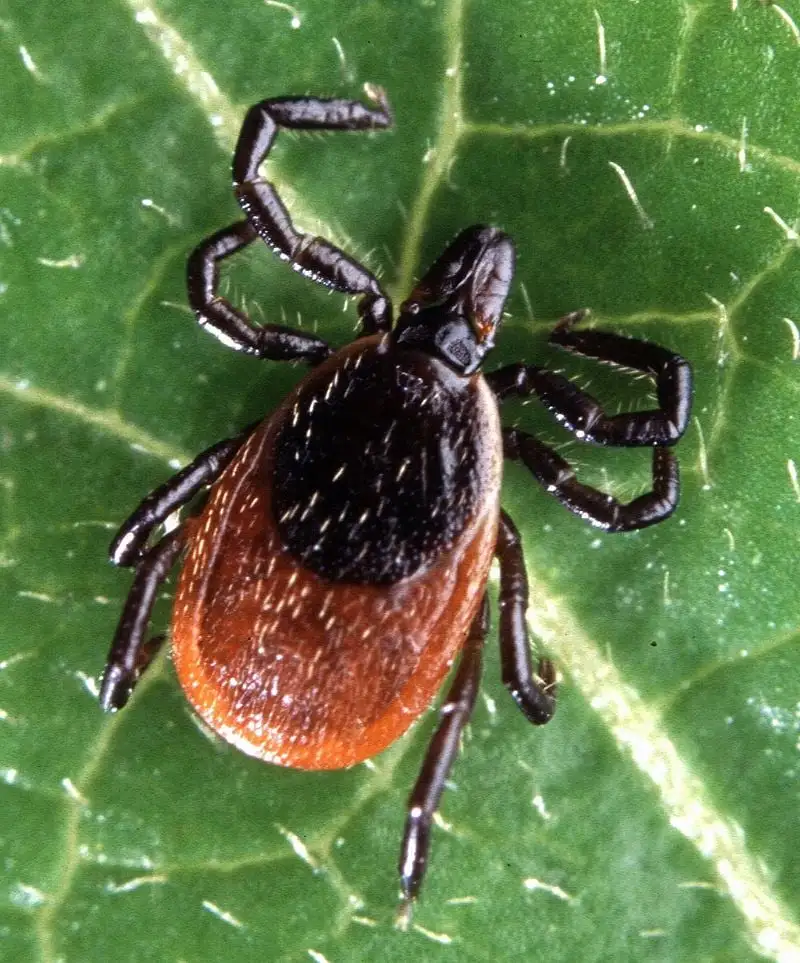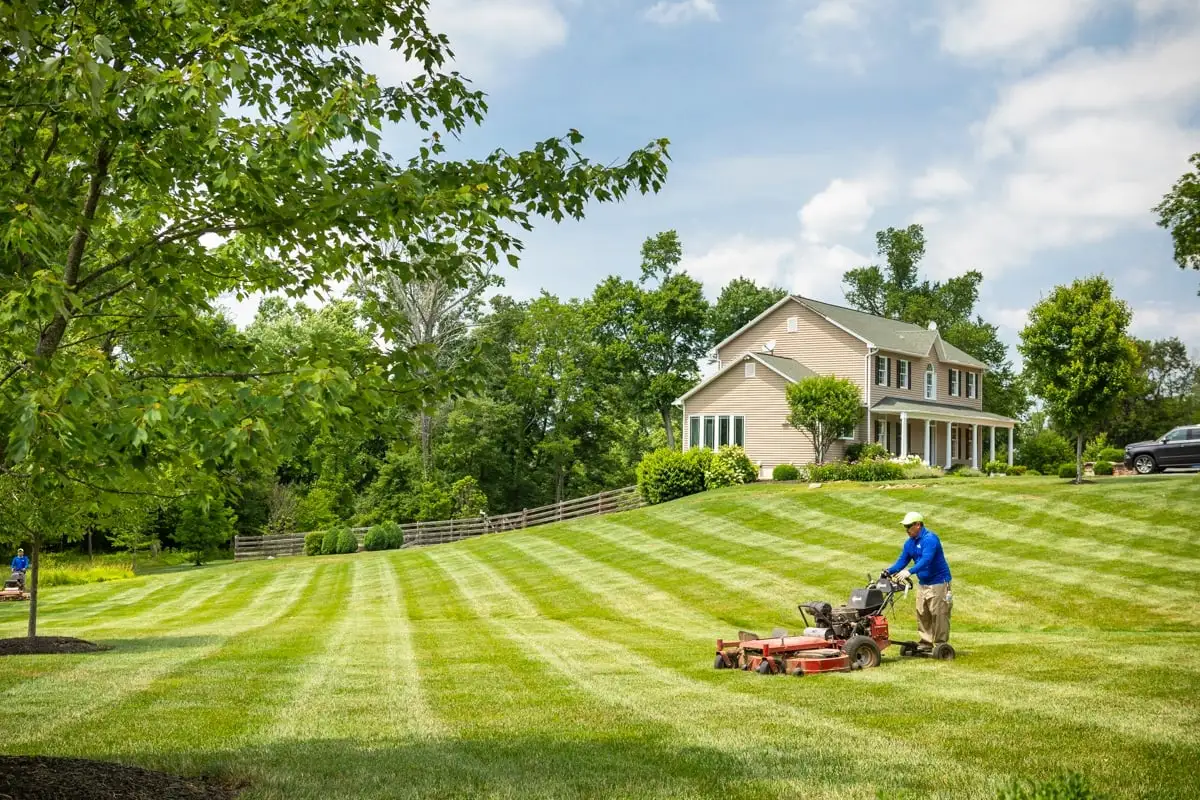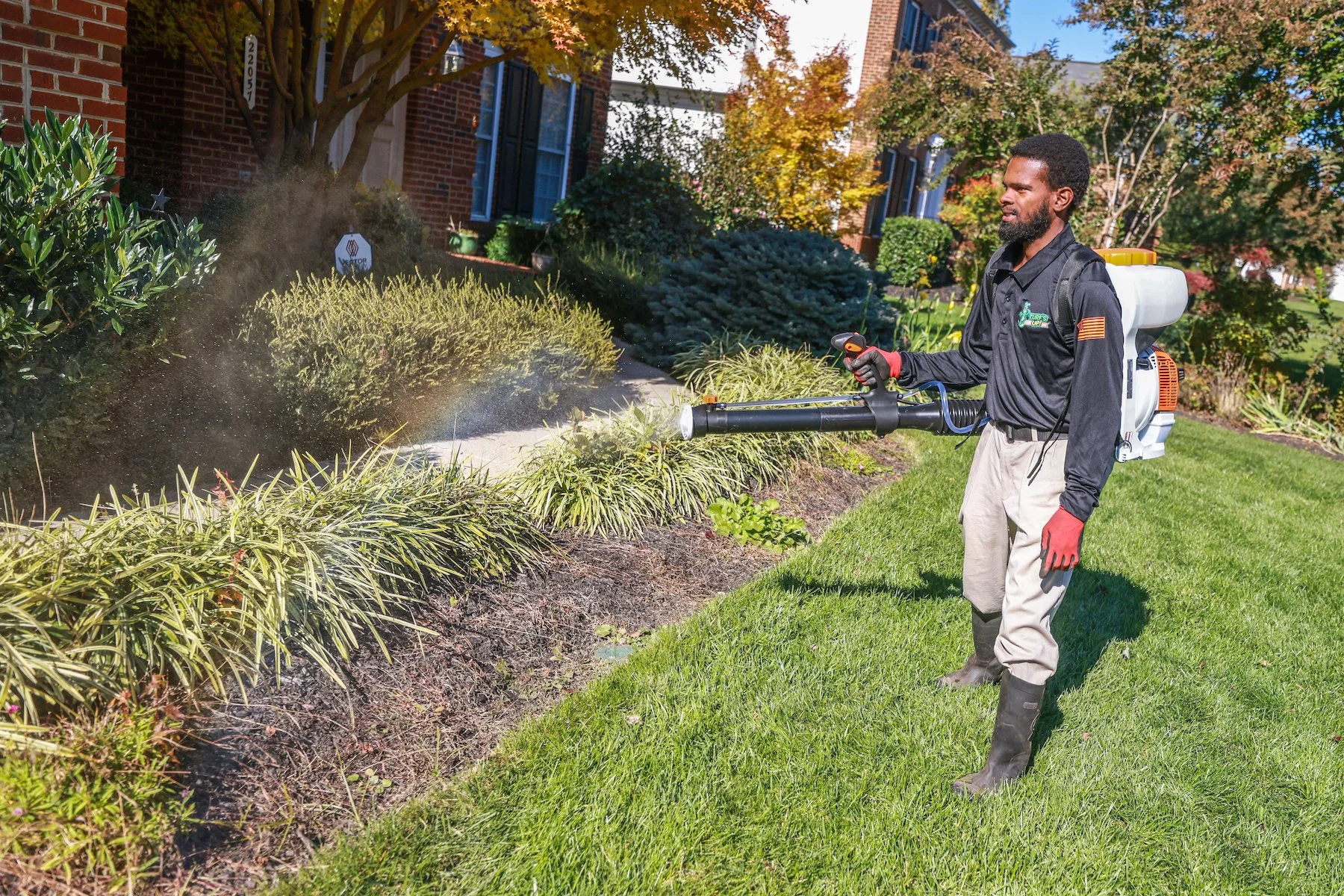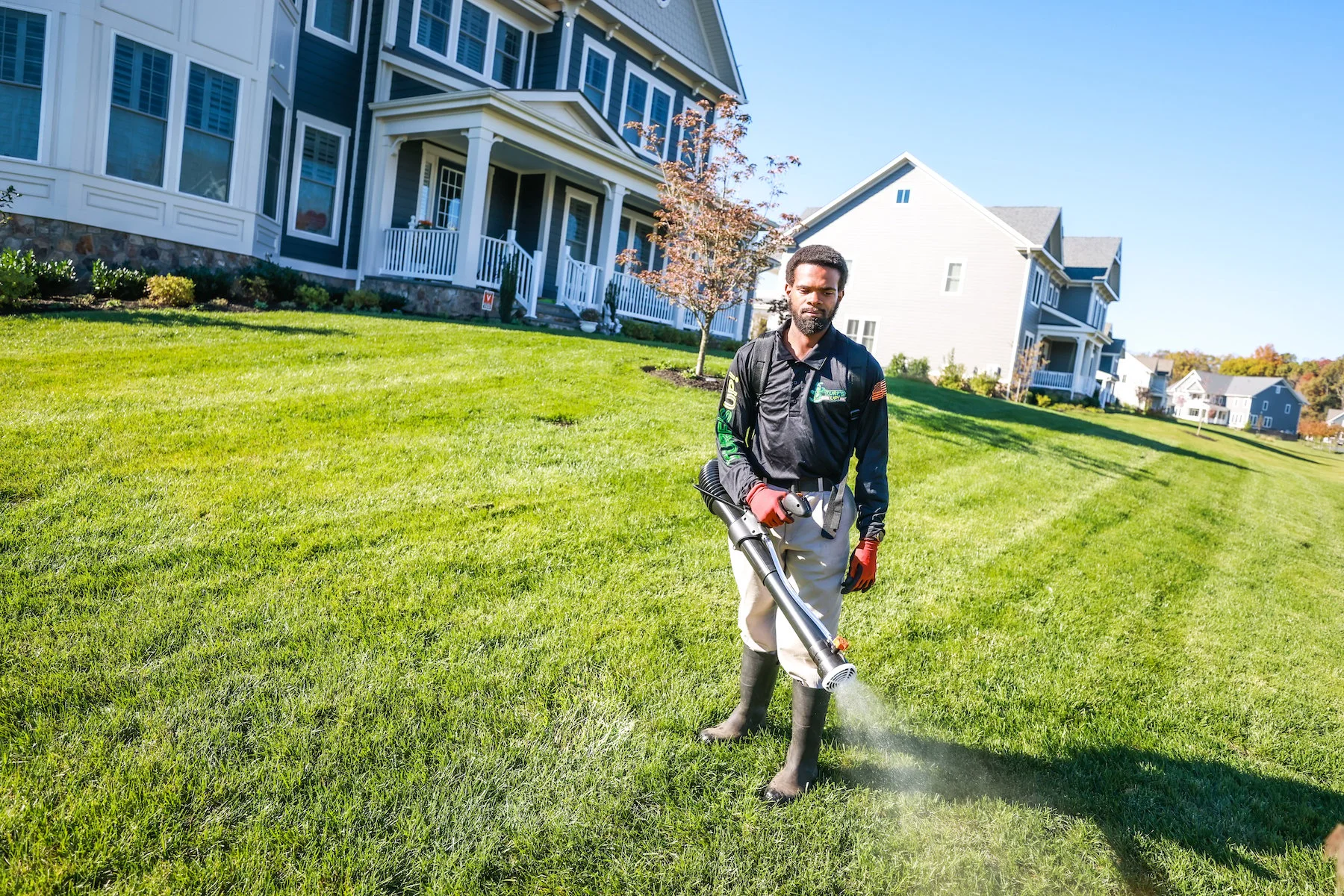Ticks might be teeny tiny, but that doesn’t mean they don’t cause big trouble.
In fact, it can even make the outdoors seem like an unfriendly place during the warmer months. After all, who wants to go outside and find ticks on themselves or their family or pets … or, even worse, suffer a tick-borne illness or disease?
That’s right, no one wants that. Not us, and not you.
And just like outdoors at a nearby park or trail, your own Northern Virginia landscape can also be home to ticks.
For that reason, you are likely wondering how you can prepare your yard for tick season. You want to do whatever it takes so you are on the right path toward having your time in your landscape ruined by these insects.
Let’s talk about why you should worry about ticks in Northern Virginia and discuss some effective strategies for keeping them out of your yard. Attention to preventive, proactive approaches will keep you ahead of the game. And, best of all, you’ll be able to enjoy your own outdoor space without worry.
Are Ticks Common in Yards in Northern Virginia?
If you’re worried about ticks in Northern Virginia, you’re not alone.
The Virginia Department of Health reports that this area of the state specifically has the highest density of ticks. And in Virginia, lyme disease is the most often reported tick-borne disease, with Rocky Mountain spotted fever and ehrlichiosis also being reported.
When you’re looking for ticks, you should know what types are in our state. The four major ticks we see in Northern Virginia are the American dog tick, brown tick, lone star tick, and the deer tick, which is also known as the blacklegged tick.

This last one is the trickiest one for Virginians, particularly when it comes to lyme disease. But Rocky Mountain spotted fever and ehrlichiosis tend to come from dog ticks and lone star ticks.
Ticks spread these diseases by feeding on the blood of animals and people. By feeding on blood they are able to grow through their four life stages. Their lifespan usually lasts about 3 years as they progress through these stages. If they don’t find blood, they die.
Not sure you have ticks? Knowing what they look like can help in preventing ticks in your yard. The lone star tick and brown tick look similar, both being 5 millimeters long and reddish-brown in color, but the lone star tick has a white spot on its back, while the brown tick does not have any white marks. The American dog tick is the same length as the lone star and brown ticks, but has light wavy lines on its back. The deer tick is the smallest of the four at 2 to 3 millimeters long, and it is off-white or red when full.
The time of day when ticks are most active can vary from species to species. Some ticks like to hunt during cool, humid early mornings or evenings, while other species like to be more active during midday when it’s dry and hot.
Why You Should Want To Prepare Your Yard For Tick Season
Preventing ticks in your yard is something that is important to keep on your to-do list.
Why do you want to prevent ticks in your yard? Because lyme disease cases from ticks in Northern Virginia have nearly doubled. The Fairfax County’s Disease Carrying Insect Program reports that almost 200 cases of the disease are identified in the county each year.
That means your chances of catching lyme disease from a single tick ranges from approximately 0% to 50%. There are 3 key things that determine your risk of contracting lyme disease from a tick:
- The tick species
- Where the tick came from
- How long the tick was actually biting you
This is really the most worrisome part of ticks – the diseases they carry. Ticks pass along more diseases than most blood-sucking pests.
Once you spot a tick on you, you want to remove it properly. Then, you’ll want to pay attention to see if you notice any symptoms of lyme disease or other diseases.
If you find a tick, don’t be alarmed. After removing it properly, you’ll want to look for certain symptoms that indicate a potential disease, according to the Centers for Disease Control.
A tick-borne illness would appear with chills or a fever first – possibly at the onset of the disease with occasional spikes. Then you might experience some aches and pains, accompanied by headache, muscle aches, and fatigue. Lyme disease adds some joint pain in here as well. Finally, another sign you might notice with lyme disease is a rash – one that looks like a red circle or a bull’s eye image.
Unfortunately, tick-borne illnesses appear different in everyone. Some cases are mild, while others require a trip to the healthcare facility. Since symptoms mirror other things, it can be tough for medical professionals to diagnose tick-borne illnesses. But early treatment is very important to reduce any changes of serious complications.
How to Prepare Your Yard for Tick Season
You can see that you certainly have good reason to be concerned about ticks in your Northern Virginia yard with their annoying bites and potential disease transmission.
Use these strategies to prepare your yard for tick season and protect your family and pets from this nasty pest.
Tick Prep Tip #1: Trim Overgrown Plants
Lots of tall grasses and vegetative brush near your home are key places where ticks like to hang out.
In fact, that’s how ticks find their meals. Ticks don’t jump on people or fall from tall trees. They use a behavior called questing. They crawl up high in tall grasses, weeds, vegetation, or shrubbery and wait for blood hosts to pass by so they can catch them.
This is why a great way for preventing ticks in your yard is to trim those tall grasses, keeping that overgrowth managed. This task is especially important to do at your property’s border edges, particularly if your home landscape backs up to woods or a prairie or preserve. The Centers for Disease Control suggests you place a 3-foot barrier of gravel or mulch between your lawn area and wooded or grassy areas beyond your property.
You might also consider these types of barriers around big family hangouts like your patio or playground.
Tick Prep Tip #2: Regularly Mow Your Lawn
You can also prepare your yard for tick season by mowing your lawn on a regular basis.
Ticks prefer all sorts of tall grasses – your lawn included.

During the growing season, you want to mow your lawn weekly, keeping it to a 3- to 4-inch height. This will help discourage ticks for hanging out too close to your home where your family, friends, and pets are most often present.
Tick Prep Tip #3: Keep Rodents Out of Your Yard
Ticks can also get close to you and your family members by traveling in on small rodents – mice, rats, squirrels, or other small mammals, and even larger ones like deer, too.
By keeping your lawn mowed and other tall grasses trimmed, you discourage these potential tick carriers from nesting in your yard.
The other thing you can do to keep them out is by keeping your trash binned up with tightly sealed lids so you’re not drawing in rodents with food. Not letting leaves or wood piles build up too close to your home is also a way to prevent ticks in your yard. Keep wood piles 20 feet from your home when possible.
Tick Prep Tip #4: Control Ticks in Your Yard With Tick Control Treatments
While the first tips we offer are for preventing ticks in your yard, you might find that ticks may still find their way in.
This is where tick control can make a huge difference. Professional tick control treatments can target ticks that have entered your property despite your best attempts at keeping them at bay.

Turf’s Up uses a natural, professional-grade product containing cedar oil to control ticks. This oil blocks ticks’ scent receptors, disrupting their bodies’ systems and functions and drying them up. We apply this product in 3-week intervals from April through October, which is about 12 treatments.
We apply this spray to tick hangouts and hotspots like ground covers, low tree branches, and under shrubs and landscape plants, as well as along your perimeters. These regular treatments can drastically reduce tick populations on your property.
Let a Professional Help you Prepare Your Yard for Ticks and Keep Them Out For Good
Ticks are certainly something you don’t want hanging around in your backyard, ruining every chance you have to go outdoors.
And since peak tick season begins in April in Northern Virginia, just prior to this is the best time to act to prepare your yard for tick season.
Professional tick control will be more effective than DIY methods, ensuring you don’t have a problem before it gets out of hand.
If you think ticks might be present in your yard or you’re worried that they will be a problem this year, give Turf’s Up a call. We know the whole idea of fighting ticks can seem overwhelming, and we want to take that burden off of your hands and make it easy for you. We’ve been fighting these pests for years and know exactly how to battle them and keep them away.
Then you get to spend as many hours as you like just sitting back and enjoying the summer day in your yard – worry free. And that peace of mind is absolutely worth it.
Ready to learn why Turf’s Up could be your totally awesome choice for tick control in Northern Virginia? We’re stoked to learn more about you and help you eliminate your ticks once and for all. Get started today with a free quote. Together, we can prepare a customized plan that is perfect for you and your yard.
Image Source: Tick





Comments (0)
Thanks for your comment!
Thanks for your feedback! Your comments have been successfully submitted! Please note, all comments require admin approval prior to display.
Error submitting comment!
There is a problem with your comment, please see below and try again.